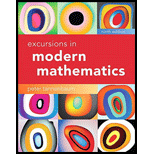
Concept explainers
Exercises 49 through 52 refer to a landmark study conducted in 1896 in Denmark by Dr. Johannes Fibiger, who went on to receive the Nobel Prize in Medicine in 1926. The purpose of the study was to determine the effectiveness of a new serum for treating diphtheria, a common and often deadly respiratory disease in those days. Fibiger conducted his study over a one-year period (May 1896–April 1897) in one particular Copenhagen hospital. New diphtheria patients admitted to the hospital received different treatments based on the day of admission. In one set of days (call them “even” days for convenience), the patients were treated with the new serum daily and received the standard treatment. Patients admitted on alternate days (the “odd” days) received just the standard treatment. Over the one-year period of the study, eight of the 239 patients admitted on the “even” days and treated with the serum died, whereas 30 of the 245 patients admitted on the “odd” days died.
a. Describe as specifically as you can the target population for Fibiger’s study.
b. Describe the sampling frame for the study.
Want to see the full answer?
Check out a sample textbook solution
Chapter 14 Solutions
Excursions in Modern Mathematics (9th Edition)
- Find all solutions of cos(x + 1) = cos(x − 1) = Π - - = 1 in the interval [0, 2π). 6arrow_forwardSolve the equation 2 cos 2x + √√3 = 0 for 0 ≤ 0 < 2π.arrow_forwardConsider y (t) — y" (t) − y' (t) + y(t) = 0 (a) Denote new variables x1(t) := y(t), x2(t) := y' (t), x3(t) = y"(t) and solve the following system 0 1 0 x1(t) X' (t) = 0 1 X(t), X(t) = x2(t) -1 1 1 x3(t) = y(t) y' (t) y" (t) (b) Use your solution to the system to find the solution to the original equation (verify!).arrow_forward
 Discrete Mathematics and Its Applications ( 8th I...MathISBN:9781259676512Author:Kenneth H RosenPublisher:McGraw-Hill Education
Discrete Mathematics and Its Applications ( 8th I...MathISBN:9781259676512Author:Kenneth H RosenPublisher:McGraw-Hill Education Mathematics for Elementary Teachers with Activiti...MathISBN:9780134392790Author:Beckmann, SybillaPublisher:PEARSON
Mathematics for Elementary Teachers with Activiti...MathISBN:9780134392790Author:Beckmann, SybillaPublisher:PEARSON
 Thinking Mathematically (7th Edition)MathISBN:9780134683713Author:Robert F. BlitzerPublisher:PEARSON
Thinking Mathematically (7th Edition)MathISBN:9780134683713Author:Robert F. BlitzerPublisher:PEARSON Discrete Mathematics With ApplicationsMathISBN:9781337694193Author:EPP, Susanna S.Publisher:Cengage Learning,
Discrete Mathematics With ApplicationsMathISBN:9781337694193Author:EPP, Susanna S.Publisher:Cengage Learning, Pathways To Math Literacy (looseleaf)MathISBN:9781259985607Author:David Sobecki Professor, Brian A. MercerPublisher:McGraw-Hill Education
Pathways To Math Literacy (looseleaf)MathISBN:9781259985607Author:David Sobecki Professor, Brian A. MercerPublisher:McGraw-Hill Education





